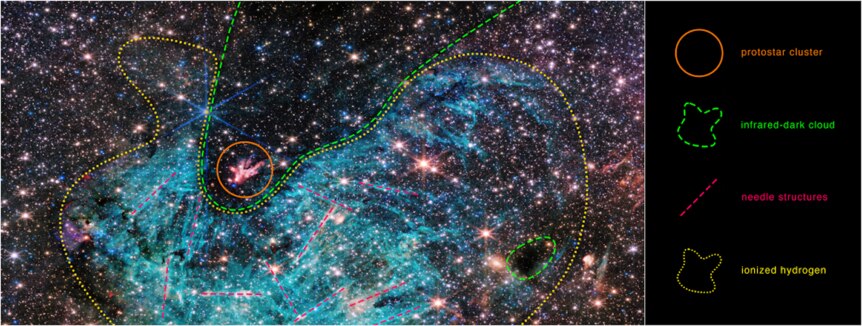Create a free profile to get unlimited access to exclusive videos, sweepstakes, and more!
JWST Peers Into the Heart of Our Own Milky Way Galaxy
It's pretty weird in the galactic inner city.
It’s a big universe out there, and there’s a lot to see outside of our tiny corner of the cosmos. A century from now, if The Ark (streaming now on Peacock) is to be believed, humanity will embark on an interstellar journey to the star next door. Getting to Proxima centauri and its collection of orbiting worlds means traversing more than four light-years of mostly empty space. And after Proxima centauri lies an entire galaxy of stars and worlds to explore.
If our descendants want to get the biggest bang for their buck, they’ll turn the nose of their ship toward the big city stellar streets of the galactic core. There, stars are packed in tightly in dense, tumultuous star-forming regions we’re only beginning to understand. The latest image from the James Webb Space Telescope (JWST) sheds new light on part of the galactic core with an image more detailed than any we’ve ever seen.
JWST Finds Weird Cosmic Structures Near Galactic Core
Astronomers pointed everyone’s favorite telescope at the star-forming region known as Sagitarrius C (Sgr C) which lies roughly 300 light-years away from Sagittarius A* (pronounced Sagittarius A Star), the black hole at the center of the Milky Way galaxy. Three hundred light-years might sound like a long way (and it is) but that’s peanuts compared to the 26,000 light-years separating us from the galactic core.
RELATED: Stunning Chaos in the Galactic Core
The image encompasses an estimated half a million stars, including a huge cluster in the process of forming and a massive monster star roughly 30 times the mass of the Sun. Those young stars dump radiation into the surrounding space where it clashes with nearby gas and dust, causing some of it to ionize and light up in the infrared. That cloud is so dense that it blocks out the visible light from the stars behind it, but JWST’s incredible near-infrared instruments allow astronomers to pick up detail like never before.
Galactic structures are revealed in the image, which were previously unknown and not wholly understood – including an expansive field of ionized hydrogen interspersed with mysterious spikes scattered chaotically throughout – and that’s precisely what scientists were hoping for. Unlike more distant galaxies, we can see the core of the Milky Way relatively close up, giving astronomers a valuable window into how stars form in the violent environment of the galactic core.
“The image from Webb is stunning, and the science we will get from it is even better,” said Samuel Crowe, the observation’s lead investigator, in a statement. “Massive stars are factories that produce heavy elements in their nuclear cores, so understanding them better is like learning the origin story of much of the universe.”
Explore the galaxy vicariously in the complete first season of The Ark, streaming now on Peacock.



































